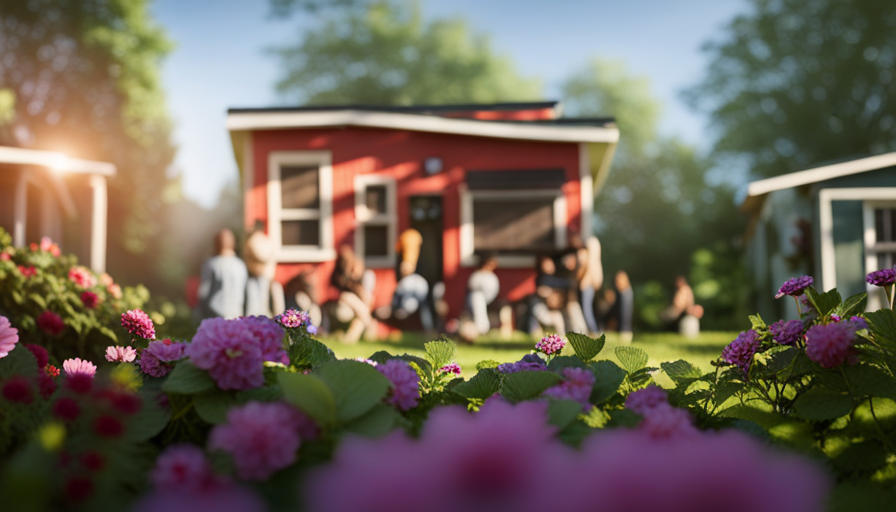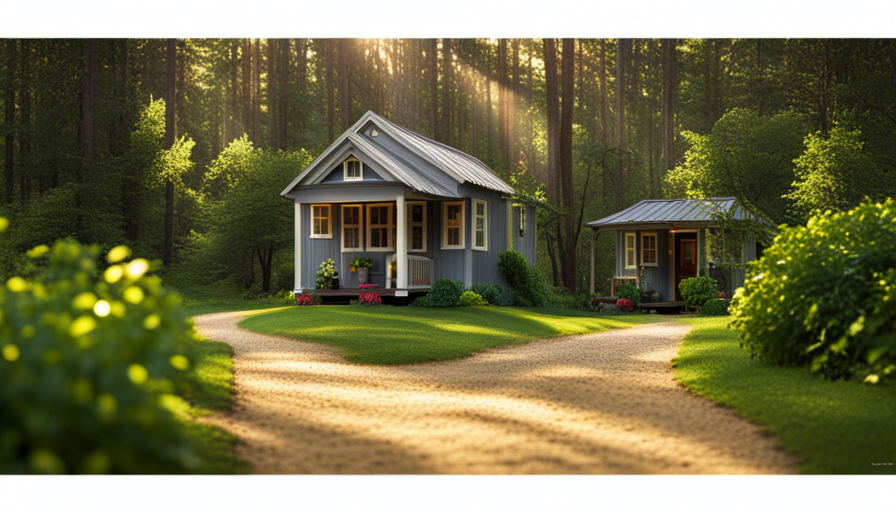Small home communities provide an innovative solution to end homelessness once and for all. These cozy houses offer more than just a roof over one’s head; they provide a glimmer of hope and a chance for a fresh start.
As I delved into the world of tiny house communities, I was astounded by the impact they have on individuals experiencing homelessness. These communities, with their affordable and sustainable housing options, not only break the cycle of homelessness but also foster a sense of belonging and community. They offer safe and dignified living conditions, empowering individuals to regain stability and rebuild their lives.
Through collaboration with local governments and organizations, these communities are making a significant difference in combating homelessness. In this article, we will explore the success stories, the impact of tiny house communities, and the future directions and challenges they face. Prepare to be inspired as we discover how these tiny homes are changing lives and giving hope to those in need.
Key Takeaways
- Tiny house communities provide affordable and sustainable housing options for individuals experiencing homelessness.
- These communities prioritize holistic care by offering supportive services for mental health and addiction.
- Tiny house communities empower individuals by providing access to job training and employment opportunities.
- Collaborations with local governments and organizations are crucial for the success and replication of tiny house communities.
Affordable and Sustainable Housing Options
Tiny house communities are providing affordable and sustainable housing options for those experiencing homelessness. These communities are built using eco-friendly materials and feature innovative designs that maximize space and minimize environmental impact. By utilizing renewable energy sources and implementing energy-efficient features, tiny houses help to reduce residents’ carbon footprints. Additionally, the use of recycled materials and sustainable building practices further contribute to the eco-friendly nature of these communities.
Not only do tiny houses offer an affordable housing solution, but they also promote a more sustainable way of living. Transitioning into the next section about fostering a sense of community, it’s important to note that these small and close-knit communities encourage residents to interact, support one another, and build meaningful connections.
Fostering a Sense of Community
In a discussion about fostering a sense of community within tiny house communities, there are three key points to consider.
First, shared facilities and amenities play a crucial role in creating a communal atmosphere, as residents can come together and utilize common spaces for various activities.
Second, a supportive and inclusive environment is essential for fostering a sense of belonging and camaraderie among community members.
Lastly, social and recreational activities organized within the community can further enhance social interactions and promote a sense of community among residents.
Shared Facilities and Amenities
Within tiny house communities, residents come together like puzzle pieces, forming a tight-knit fabric that weaves support and companionship into the lives of those experiencing homelessness. These communities provide shared facilities and amenities that foster a sense of belonging and improve quality of life.
Some of the key features include:
- Shared kitchen: Residents can gather and prepare meals together, promoting a sense of community and shared responsibility.
- Community gardens: These spaces provide residents with the opportunity to grow their own food, fostering self-sufficiency and promoting a healthier lifestyle.
- Common areas: Shared spaces such as parks, playgrounds, and recreational areas encourage social interaction and create a sense of unity among residents.
- Laundry facilities: Access to laundry facilities within the community ensures that residents have clean clothes and maintain personal hygiene.
These shared facilities and amenities not only meet practical needs but also create opportunities for residents to connect and support one another. Transitioning into the subsequent section about a supportive and inclusive environment, these communities go beyond providing physical necessities to create a nurturing space where individuals experiencing homelessness can thrive.
Supportive and Inclusive Environment
Nurturing a sense of belonging, these close-knit communities create an environment where individuals experiencing homelessness can thrive and find support. Tiny house communities provide not only supportive housing but also an inclusive community that encourages social connections and personal growth.
Residents are surrounded by a network of peers who understand their struggles and offer empathy and encouragement. The supportive environment fosters a sense of safety and stability, allowing individuals to focus on rebuilding their lives. Community members often participate in regular meetings and workshops, where they can learn new skills, receive counseling, and access resources to address their specific needs.
This inclusive approach ensures that everyone has a voice and can actively contribute to the community’s success. Transitioning to the next section about social and recreational activities, these opportunities further promote socialization and well-being.
Social and Recreational Activities
Engaging in various social and recreational activities allows me to connect with others and enhance my well-being. In tiny house communities, there are plenty of opportunities to participate in outdoor activities and creative workshops.
These activities not only promote physical fitness but also provide a platform for individuals to express themselves and develop new skills. Whether it’s gardening, hiking, or playing sports, the outdoor activities in these communities foster a sense of community and encourage residents to lead an active lifestyle.
Additionally, creative workshops such as painting, pottery, and cooking classes offer residents a chance to explore their artistic side and engage in meaningful and fulfilling activities. These social and recreational activities create a vibrant and inclusive atmosphere in tiny house communities, promoting social interaction and personal growth.
As we move into the next section about providing safe and dignified living conditions, it’s important to highlight the holistic approach these communities take to address homelessness.
Providing Safe and Dignified Living Conditions
Tiny house communities offer a safe and dignified way for individuals experiencing homelessness to have a place they can truly call home. These communities provide safe housing options that prioritize the well-being and security of their residents.
The tiny houses themselves are built with sturdy materials and equipped with basic amenities such as heating, plumbing, and electricity, ensuring a comfortable living environment. Additionally, these communities often have security measures in place, such as gated entrances and surveillance cameras, to further enhance the safety of residents.
By offering dignified living conditions, tiny house communities aim to restore a sense of pride and self-worth for individuals who have experienced homelessness. This stable and secure housing is a crucial first step in empowering individuals to regain stability and move towards a brighter future.
Empowering Individuals to Regain Stability
Access to job training and employment opportunities is a vital aspect of empowering individuals to regain stability. By providing access to these resources, individuals experiencing homelessness can gain the necessary skills and knowledge to secure stable employment and improve their financial situation.
Additionally, supportive services for mental health and addiction play a crucial role in helping individuals address underlying issues that may have contributed to their homelessness, enabling them to regain stability in their lives.
Finally, education and skill-building programs offer opportunities for individuals to acquire new skills and knowledge, ultimately enhancing their chances of finding sustainable employment and achieving long-term stability.
Access to Job Training and Employment Opportunities
Job training and employment opportunities in tiny house communities are like golden tickets to a world of endless possibilities for the homeless. These communities prioritize job placement and vocational training as essential components of their support system. Through partnerships with local businesses and organizations, residents are provided with the necessary skills and resources to secure stable employment.
Vocational training programs offer specialized courses in various fields, such as construction, hospitality, and healthcare, ensuring that individuals can find work in industries that match their interests and abilities. Moreover, these communities offer job placement assistance, connecting residents with job openings and helping them navigate the application process.
By providing access to job training and employment opportunities, tiny house communities empower individuals to regain stability and build a brighter future. Transitioning into the subsequent section about supportive services for mental health and addiction, these communities also prioritize holistic care to address the underlying challenges that contribute to homelessness.
Supportive Services for Mental Health and Addiction
Moving from the topic of job training and employment opportunities, let’s now explore the supportive services that tiny house communities provide for mental health and addiction. These communities recognize the importance of addressing these issues to help individuals experiencing homelessness regain stability and improve their overall well-being.
In order to address mental health concerns, tiny house communities often offer access to mental health services, including counseling and therapy. These services are crucial in helping individuals cope with the challenges they face and work towards their recovery. Additionally, addiction recovery programs are available to support those struggling with substance abuse. These programs provide resources, guidance, and a supportive community to aid in the journey towards sobriety.
By offering these supportive services, tiny house communities strive to create an environment where individuals can heal and rebuild their lives. As we transition to the next section on education and skill-building programs, we will explore how these communities empower individuals through learning opportunities and professional development.
Education and Skill-building Programs
Through the implementation of various educational and skill-building programs, these supportive communities foster personal growth and empower individuals to enhance their knowledge and abilities.
Education programs play a vital role in helping residents gain new skills and knowledge that can lead to improved employment prospects and long-term stability. These programs often include vocational training, where residents can learn practical skills such as carpentry, plumbing, or culinary arts.
By offering these educational opportunities, tiny house communities enable individuals experiencing homelessness to acquire the necessary tools to secure gainful employment and become self-sufficient. Moreover, these programs provide a sense of purpose and fulfillment for the residents, boosting their self-esteem and motivation to succeed.
As a result, they become more equipped to transition out of homelessness and reintegrate into society. Moving forward, collaborating with local governments and organizations will further enhance the impact of these educational initiatives.
Collaborating with Local Governments and Organizations
By forming partnerships with local governments and organizations, tiny house communities have become beacons of hope, shining a light on the path towards a brighter future for those experiencing homelessness. These collaborative partnerships have been instrumental in addressing the complex issue of homelessness by leveraging the unique strengths and resources of each stakeholder.
Some ways in which tiny house communities collaborate with local governments and organizations include:
- Advocacy and policy support: Working together to advocate for policies that support affordable housing and provide necessary resources for homeless individuals.
- Funding and grants: Collaborating to secure funding and grants to support the development and maintenance of tiny house communities.
- Service provision: Partnering with local service providers to ensure residents have access to essential services such as healthcare, counseling, and job training.
- Community engagement: Involving local residents and organizations in the planning and implementation of tiny house communities, fostering a sense of community and shared responsibility.
These collaborative efforts have resulted in significant success stories and positive impacts on individuals and communities affected by homelessness. Transitioning into the subsequent section about ‘success stories and impact,’ these partnerships have played a crucial role in transforming lives and creating sustainable solutions for homelessness.
Success Stories and Impact
In collaborating with local governments and organizations, tiny house communities have already shown promising results in addressing homelessness. Now, let’s delve into some success stories and examine the impact these communities have had on individuals and society as a whole.
One notable success story is the Dignity Village in Portland, Oregon. Since its establishment in 2000, this tiny house community has provided stable housing for over 60 previously homeless individuals. Not only has it improved the living conditions of its residents, but it has also fostered a sense of community and self-governance.
Moreover, these communities have demonstrated long-term success by empowering individuals to transition out of homelessness and into more stable housing options. Additionally, they have had a positive economic impact by reducing the strain on public resources and providing employment opportunities within the community.
As we look towards future directions and challenges, it is essential to explore how these communities can further expand and replicate their success to create a lasting solution to homelessness.
Future Directions and Challenges
Looking ahead, the future of addressing homelessness lies in the expansion and replication of successful models like Dignity Village. These tiny house communities have demonstrated their effectiveness in providing safe and affordable housing for the homeless population.
However, in order to continue their growth and make a lasting impact, future funding is crucial. Government support, private donations, and grants can help sustain and expand these communities, allowing more individuals to find stability and support.
Additionally, community engagement plays a vital role in the success of tiny house communities. By fostering relationships with local businesses, organizations, and residents, these communities can create a sense of belonging and create opportunities for residents to access resources and services.
Encouraging community involvement and support will be essential in overcoming future challenges and ensuring the long-term success of tiny house communities in addressing homelessness.
Frequently Asked Questions
How are tiny house communities funded and financed?
One challenge in funding and financing tiny house communities is the perception that they’re not a sustainable solution to homelessness. However, there are several solutions to overcome this challenge.
For example, crowdfunding campaigns and grants can help raise funds. Additionally, partnerships with local governments and non-profit organizations can provide financial support.
These communities also have a positive impact on the local economy by creating jobs and increasing property values.
What are the criteria for individuals to be eligible for housing in a tiny house community?
To be eligible for housing in a tiny house community, individuals must meet specific eligibility criteria.
These criteria typically include being homeless or at risk of homelessness, having a low income, and demonstrating a need for affordable housing.
Additionally, support services are often provided within these communities to assist residents in their journey towards self-sufficiency.
These services may include access to healthcare, mental health support, job training, and other resources to help individuals regain stability and independence.
Are there any specific regulations or guidelines that govern the construction and maintenance of tiny houses in these communities?
Construction regulations and maintenance guidelines play a crucial role in ensuring the safety and sustainability of tiny house communities. These regulations vary depending on the location, but they typically cover aspects such as size limitations, foundation requirements, and utility connections.
Maintenance guidelines often include regular inspections for safety and compliance, as well as guidelines for waste management and landscaping. Adhering to these regulations and guidelines helps maintain the integrity and livability of tiny house communities.
How do tiny house communities address the issue of basic necessities like healthcare and education for their residents?
In tiny house communities, we prioritize the well-being and development of our residents. We ensure healthcare accessibility through partnerships with local clinics and healthcare providers. Residents have access to basic medical services, including check-ups and vaccinations.
Additionally, we collaborate with educational organizations to provide educational resources availability. We offer adult education programs, vocational training, and tutoring services for children. Our goal is to empower our residents with the necessary tools for a brighter future.
How do tiny house communities ensure the safety and security of their residents, particularly in terms of preventing crime and providing emergency services?
Emergency response systems and crime prevention strategies are crucial in ensuring the safety and security of residents in tiny house communities. These communities often have established emergency protocols in place, such as alert systems and designated safe areas. Additionally, they may employ security personnel or install security cameras to deter crime and provide a sense of safety.
Regular community meetings and collaboration with local law enforcement also contribute to a proactive approach in preventing crime and addressing emergency situations promptly.
Conclusion
In conclusion, the rise of tiny house communities has been a beacon of hope for those experiencing homelessness. These communities not only offer affordable and sustainable housing options, but they also foster a sense of community and provide safe and dignified living conditions. By empowering individuals to regain stability, they’re helping to break the cycle of homelessness. Collaboration with local governments and organizations has been instrumental in their success.
Although challenges lie ahead, these communities are a shining light in the fight against homelessness, like a lighthouse guiding ships to safety in a stormy sea.
Hi, I’m Emma. I’m the Editor in Chief of Tiny House 43, a blog all about tiny houses. While tree houses are often associated with childhood, they can be the perfect adult retreat. They offer a cozy space to relax and unwind, surrounded by nature. And since they’re typically built on stilts or raised platforms, they offer stunning views that traditional homes simply can’t match. If you’re looking for a unique and romantic getaway, a tree house tiny house might just be the perfect option.










